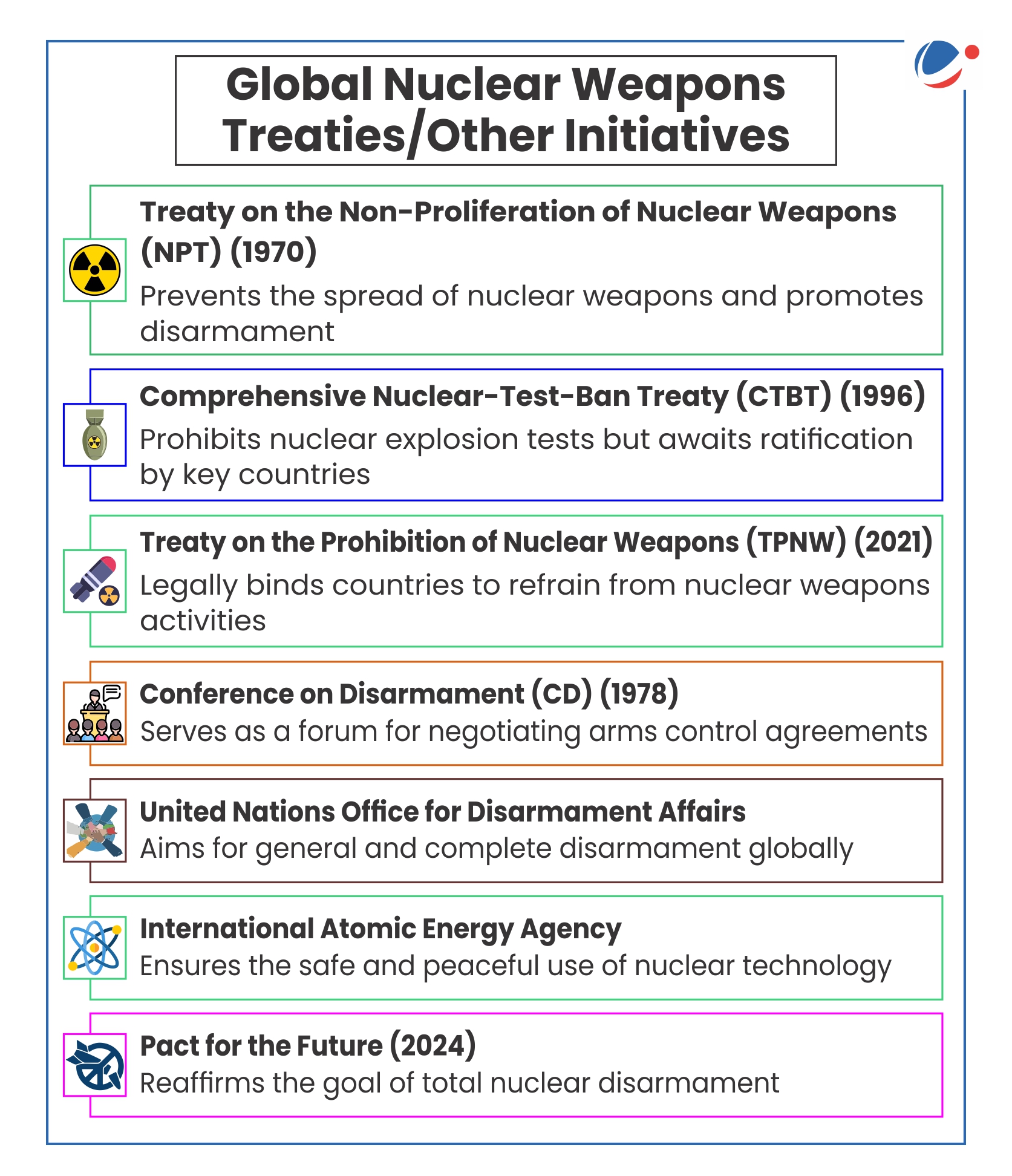Why in the news?
UN Secretary-General António Guterres warned at the "UN Conference on Disarmament" in Geneva that the risk of nuclear war is rising and urged governments to push for total disarmament.
Factors behind Rising Risk of Nuclear War
- Geopolitical Risks: Rising Geopolitical tensions push nations toward nuclear security. For example, Russia suspended the New Strategic Arms Reduction Treaty (New START) and withdrew from the Comprehensive Nuclear Test Ban Treaty (CTBT), during the Ukraine war.
- Doomsday Clock Alert: In January 2025, the symbolic clock moved one second closer to catastrophe, signaling rising nuclear war risks.
- Expanding Nuclear Arsenals: Global stockpiles exceed 12,000 warheads, with nations upgrading delivery systems.
- E.g., China may reach 1,500 "operational" nuclear warheads by 2035 (Pentagon Report, 2022), signaling rapid expansion.
- Nuclear Modernization Risks: For example, Hypersonic missiles reduce response time, increasing the risk of misidentification and rapid escalation.
- Risk of False Alarms & Accidental Escalation: As highlighted during the 1983 Soviet false alarm incident, where early warning systems wrongly detected a U.S. strike, later prevented by human intervention.
- Newer Technologies: Weaponization of Artificial Intelligence is moving forward at an alarming pace which raises concerns over automated nuclear decision-making.
- Arms Race Spreading to Outer Space: such as U.S. Space Force Expansion, India's ASAT Test (Mission Shakti, 2019) etc.
What is Nuclear Disarmament?

- Nuclear disarmament refers to the act, by unilateral decision or international agreement, of reducing or eliminating the total number of nuclear weapons worldwide, with the end goal of a nuclear-free world.
Key Obstacles to Nuclear Disarmament Efforts
- Commitment vs. Implementation Gap: Nuclear states pledge disarmament on one hand but modernize arsenals on the other.
- E.g., Russia supports NPT and START but has also developed ICBMs and hypersonic weapons.
- Key Issues Regarding Global Disarmament Initiatives:
- Ineffective Implementation: The Conference on Disarmament has made little progress in two decades, raising skepticism about disarmament efforts.
- Loopholes in Treaties: Treaties like the NPT contain vague provisions, allowing nuclear-armed states to delay or evade commitments.
- E.g., USA & USSR focused on stopping others from acquiring nuclear weapons but avoided binding self-reduction.
- Withdrawal from Agreements: E.g., North Korea (DPRK) exited NPT and conducted nuclear tests, setting a precedent for treaty non-compliance.
- Bilateral Arms Control Failure: The Intermediate-Range Nuclear Forces (INF) Treaty, banning ground-launched missiles (500–5500 km), collapsed after the U.S. accused Russia of violations, exposing major powers' disarmament failures.
- Outside Disarmament Framework: Three De-facto Nuclear States (India, Israel, and Pakistan) remain outside the NPT, challenging global disarmament efforts.
- Global Military Imbalance: In 2023, the U.S. spent $916B (37% of global defense spending), while Russia spent $109B (4.5%). This significant gap reinforces Russia's reliance on nuclear deterrence for strategic balance.
- Other Issues:
- Prestige and Power Symbolism: Nuclear weapons enhance national status, discouraging disarmament (UN observation).
- Lack of Legal Framework: No binding multilateral treaty specifically regulates missiles.
- NATO Nuclear Doctrine: NATO upholds nuclear deterrence to prevent coercion and aggression, hindering disarmament.
- Mutually Assured Destruction (MAD) Doctrine: The U.S. and Russia rely on MAD, assuming overwhelming retaliation would discourage either side from launching an attack.
India's stance on Nuclear Disarmament
|
Way Forward
- Transitional Approach: A phased strategy balancing deterrence and disarmament, ensuring security while gradually reducing nuclear reliance. It covers -
- Bilateral Arms Reduction: The U.S. and Russia, holding the largest nuclear stockpiles, must lead by example by reviving stalled New START negotiations to reduce arsenals.
- Adopting Minimal Nuclear Deterrence & No-First-Use (NFU) Policy.
- Treaty-based limits on strategic missile defences in the light of emerging hypersonic weapons.
- Strengthened international norms against both nuclear and conventional aggression, in particular against preventive war.
- Need for Global Cooperation: Inspired by the Cold War era, health professionals should continue International Physicians for the Prevention of Nuclear War (IPPNW) nuclear disarmament efforts, which earned the 1985 Nobel Peace Prize.
- UN's Role in Disarmament: UN Secretary-General António Guterres urged new negotiations to prevent an arms race in outer space, emphasizing a stronger UN role in global security and disarmament.



